2023年高考英语一轮专题复习:冠词(1) 课件(22张ppt)
文档属性
| 名称 | 2023年高考英语一轮专题复习:冠词(1) 课件(22张ppt) |  | |
| 格式 | pptx | ||
| 文件大小 | 317.8KB | ||
| 资源类型 | 教案 | ||
| 版本资源 | 通用版 | ||
| 科目 | 英语 | ||
| 更新时间 | 2022-10-26 15:18:36 | ||
图片预览


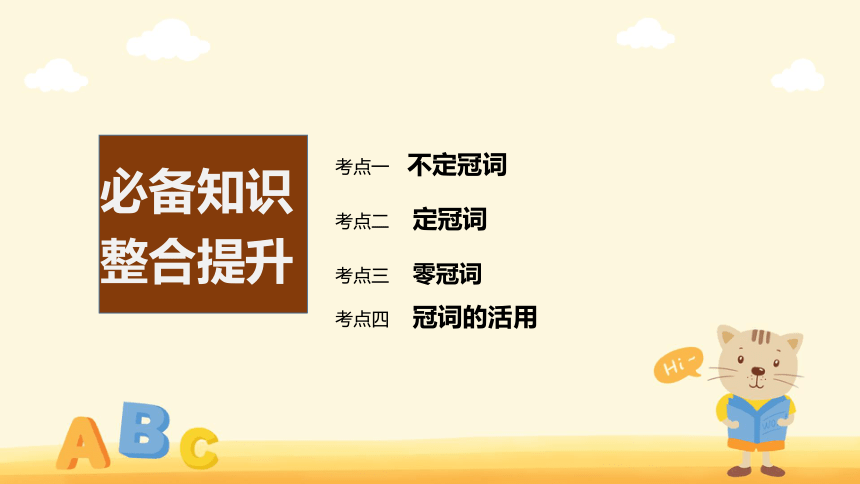
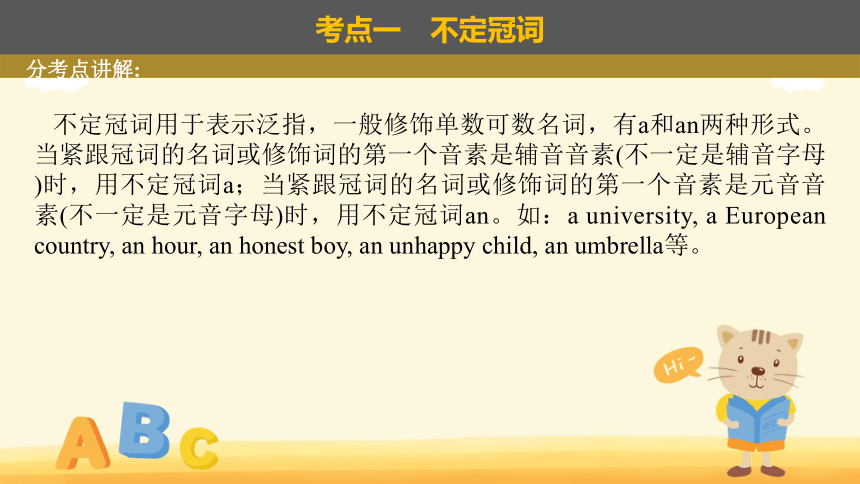
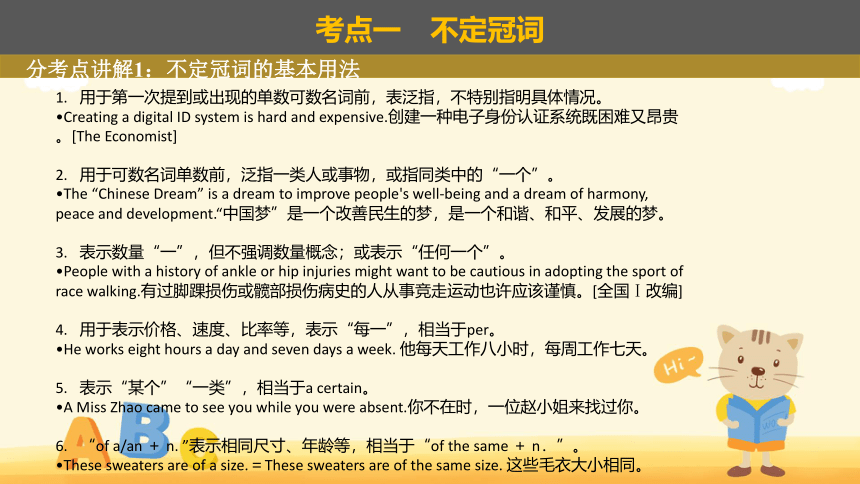
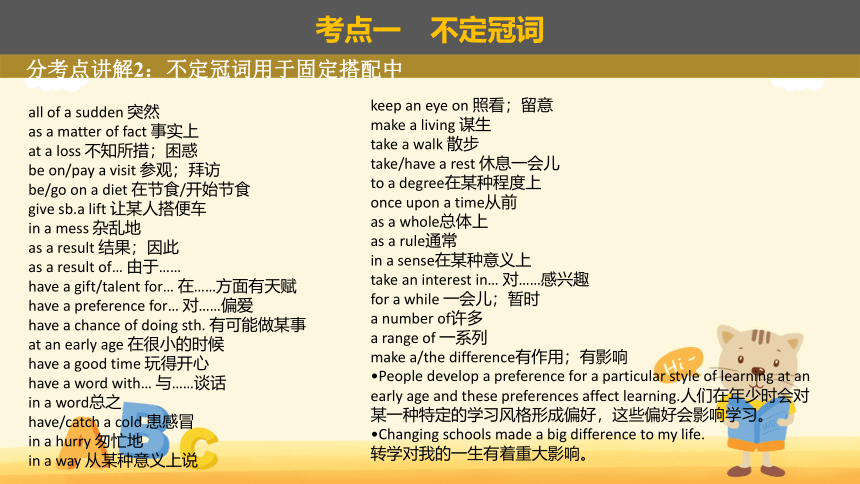
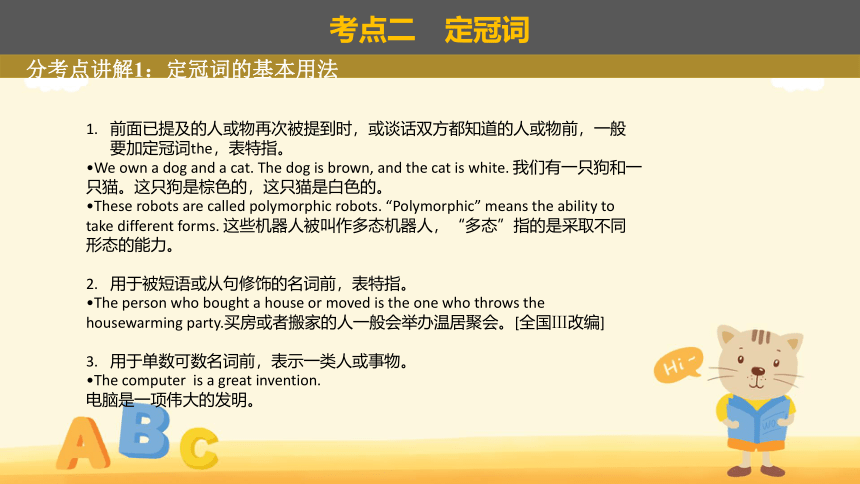

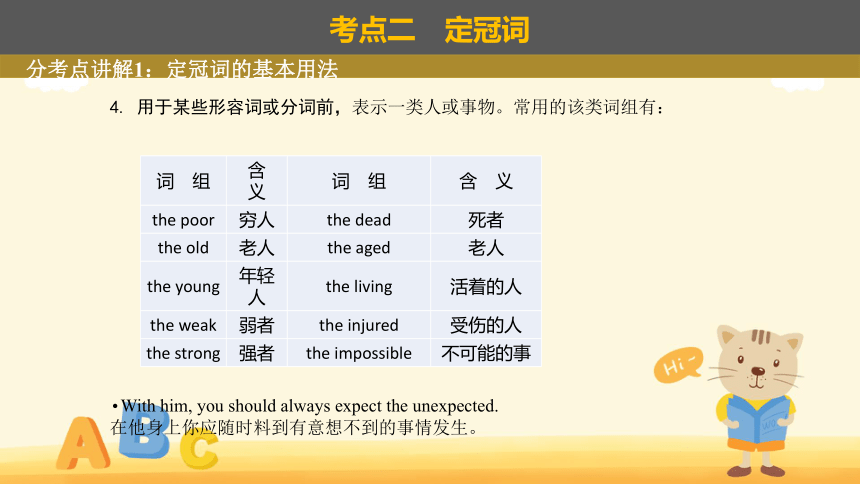
文档简介
(共22张PPT)
专题一 冠词
第1讲 冠词讲解(1)
必备知识 整合提升
核心考法 重难突破
易混知识 易错清单
冠词
强化模拟 限时训练
必备知识
整合提升
考点一 不定冠词
考点二 定冠词
考点三 零冠词
考点四 冠词的活用
考点一 不定冠词
不定冠词用于表示泛指,一般修饰单数可数名词,有a和an两种形式。当紧跟冠词的名词或修饰词的第一个音素是辅音音素(不一定是辅音字母)时,用不定冠词a;当紧跟冠词的名词或修饰词的第一个音素是元音音素(不一定是元音字母)时,用不定冠词an。如:a university, a European country, an hour, an honest boy, an unhappy child, an umbrella等。
分考点讲解:
考点一 不定冠词
分考点讲解1:不定冠词的基本用法
用于第一次提到或出现的单数可数名词前,表泛指,不特别指明具体情况。
Creating a digital ID system is hard and expensive.创建一种电子身份认证系统既困难又昂贵。[The Economist]
用于可数名词单数前,泛指一类人或事物,或指同类中的“一个”。
The “Chinese Dream” is a dream to improve people's well being and a dream of harmony, peace and development.“中国梦”是一个改善民生的梦,是一个和谐、和平、发展的梦。
表示数量“一”,但不强调数量概念;或表示“任何一个”。
People with a history of ankle or hip injuries might want to be cautious in adopting the sport of race walking.有过脚踝损伤或髋部损伤病史的人从事竞走运动也许应该谨慎。[全国Ⅰ改编]
用于表示价格、速度、比率等,表示“每一”,相当于per。
He works eight hours a day and seven days a week. 他每天工作八小时,每周工作七天。
表示“某个”“一类”,相当于a certain。
A Miss Zhao came to see you while you were absent.你不在时,一位赵小姐来找过你。
“of a/an + n. ”表示相同尺寸、年龄等,相当于“of the same + n.”。
These sweaters are of a size.=These sweaters are of the same size. 这些毛衣大小相同。
考点一 不定冠词
分考点讲解2:不定冠词用于固定搭配中
all of a sudden 突然
as a matter of fact 事实上
at a loss 不知所措;困惑
be on/pay a visit 参观;拜访
be/go on a diet 在节食/开始节食
give sb.a lift 让某人搭便车
in a mess 杂乱地
as a result 结果;因此
as a result of… 由于……
have a gift/talent for… 在……方面有天赋
have a preference for… 对……偏爱
have a chance of doing sth. 有可能做某事
at an early age 在很小的时候
have a good time 玩得开心
have a word with… 与……谈话
in a word总之
have/catch a cold 患感冒
in a hurry 匆忙地
in a way 从某种意义上说
keep an eye on 照看;留意
make a living 谋生
take a walk 散步
take/have a rest 休息一会儿
to a degree在某种程度上
once upon a time从前
as a whole总体上
as a rule通常
in a sense在某种意义上
take an interest in… 对……感兴趣
for a while 一会儿;暂时
a number of许多
a range of 一系列
make a/the difference有作用;有影响
People develop a preference for a particular style of learning at an early age and these preferences affect learning.人们在年少时会对某一种特定的学习风格形成偏好,这些偏好会影响学习。
Changing schools made a big difference to my life.
转学对我的一生有着重大影响。
考点二 定冠词
分考点讲解1:定冠词的基本用法
前面已提及的人或物再次被提到时,或谈话双方都知道的人或物前,一般要加定冠词the,表特指。
We own a dog and a cat. The dog is brown, and the cat is white. 我们有一只狗和一只猫。这只狗是棕色的,这只猫是白色的。
These robots are called polymorphic robots. “Polymorphic” means the ability to take different forms. 这些机器人被叫作多态机器人,“多态”指的是采取不同形态的能力。
用于被短语或从句修饰的名词前,表特指。
The person who bought a house or moved is the one who throws the housewarming party.买房或者搬家的人一般会举办温居聚会。[全国Ⅲ改编]
用于单数可数名词前,表示一类人或事物。
The computer is a great invention.
电脑是一项伟大的发明。
考点二 定冠词
分考点讲解1:定冠词的基本用法
特别注意:
不定冠词和定冠词均可与单数可数名词连用,表示类别,但前者通常强调个体,即泛指该类别中的“任何一个”,后者通常强调整体。
I know that the pressure to stay slim is a problem, especially for an actress.我知道保持身材苗条的压力是个问题,尤其是对女演员来说。(强调类别中的“任何一个”)
The tiger is in danger of dying out.
老虎有灭绝的危险。(强调整体)
考点二 定冠词
分考点讲解1:定冠词的基本用法
词 组 含 义 词 组 含 义
the poor 穷人 the dead 死者
the old 老人 the aged 老人
the young 年轻人 the living 活着的人
the weak 弱者 the injured 受伤的人
the strong 强者 the impossible 不可能的事
4. 用于某些形容词或分词前,表示一类人或事物。常用的该类词组有:
With him, you should always expect the unexpected.
在他身上你应随时料到有意想不到的事情发生。
考点二 定冠词
分考点讲解1:定冠词的基本用法
5. 用于形容词或副词的最高级前。
Plastic straws are by no means the biggest source of plastic pollution.塑料吸管绝对不是塑料污染的最大来源。[全国乙改编]
特别注意:
(1)only, very, same, main等词修饰名词时,前面也用定冠词the。
He hung the paintings above the same table he had moved from Turin.
他把这些画挂在同一张桌子的上面,这张桌子是他从都灵搬来的。[全国Ⅱ改编]
This is the only expensive dress I've bought.
这是我买的唯一一件贵的连衣裙。
(2)a与most连用,位于形容词前时,most是表示程度的副词,意为“非常”;the与most连用,位于形容词或副词前时,most是最高级的标志,意为“最……的/地”。
Historical experience can serve as a most important source of information.
历史经验能充当一种非常重要的信息来源。
The most energetic and important festivals are the ones that look forward to the end of winter and to the coming of spring.
最富有生气而又最重要的节日,就是告别冬天、迎来春天的节日。
考点二 定冠词
分考点讲解1:定冠词的基本用法
6. 用于表示演奏的乐器的名词前。
The girl practices the violin every day.
这个女孩每天练习拉小提琴。
特别注意:
若不是从演奏角度来考虑,而只是提及乐器,则表示乐器的名词前不一定用定冠词。
There is a violin in his school.
他学校里有一把小提琴。
He teaches violin in this school.
他在这所学校教小提琴。
考点二 定冠词
分考点讲解1:定冠词的基本用法
7. 用于表示姓氏的名词复数前,表示“一家人”或“夫妇二人”。
The Lincolns enlarged the house to a full two stories in 1856 to meet the needs of their growing family.林肯夫妇在1856年把房子扩建成了整整两层,以满足他们家人口逐渐增加的需要。[浙江高考]
8. 用于表示朝代、年代的名词前,或者用于整十的数词复数(表示某个年代)前。
The band broke up in about 1970, but happily they reunited in the mid 1980s.
乐队在1970年左右解散了,但令人高兴的是,他们在20世纪80年代中期又重组起来了。
He moved to the south in the fifties.
他在50年代搬到了南方。
特别注意:
表示“某人……多岁”时,则用“in + one's + 整十的数词复数”。
Her father is in his fifties.
她的父亲50多岁了。
考点二 定冠词
分考点讲解1:定冠词的基本用法
9. 用在表示度量单位的单数名词前,如by the hour/day/week/month/year/kilo/ton/dozen等。但size, weight, time这类名词跟by连用时,其前不加定冠词。
Flour is sold by the kilo.
面粉按千克出售。
Fruit and vegetables are sold by weight.
水果和蔬菜是称重出售的。
10. 用于“动词(hit, strike, pull, take等) + sb.+ 介词 + the + 表示身体某部位的名词”结构中,该结构中的the不可用形容词性物主代词代替。
hit sb.on the head/chin 打某人的头/下巴
pat sb.on the shoulder拍某人的肩
pull sb.by the hand 拉某人的手
take sb.by the arm/hand 抓住某人的胳膊/手
take sb.by the throat扼住某人的咽喉
strike sb.in the face 打某人的脸
A stone hit him on the head.
一块石头打到了他的头。
11. 用在某些含有普通名词的专有名词前。
the Great Wall长城 the World Cup世界杯
考点二 定冠词
分考点讲解2:定冠词用于固定搭配中
at the moment 此刻;目前
at the same time 同时
by the way 顺便说一下
all the way 一路上;自始至终
to the point 中肯;切题
go to the cinema/theater 去看电影/戏剧
in the distance 在远处
in the end 最后;最终
all over the world 全世界
at the top of… 在……顶端
one… the other... 一个……另一个……
in the habit of… 有……的习惯
make the most of… 充分利用……
not in the least 一点也不
on the contrary 与此相反
on the other hand 另一方面
the other day 几天前;那天
to tell (you) the truth (跟你)说实话
Church bells rang in the distance.
远处教堂的钟声响起。
We should make the most of every minute.
我们应该充分利用每一分钟。
考点三 零冠词
分考点讲解1:零冠词的基本用法
1. 复数名词或不可数名词表泛指时,其前不加冠词。
Only athletes who have reached the agreed standard for their event will be admitted as competitors.只有达到他们比赛项目规定水平的运动员才被允许参加比赛。
The staff is friendly and helpful, offering advice if you require some.工作人员很友好且乐于助人,如果你需要一些建议,他们会提供给你。[全国新高考Ⅰ改编]
2. 名词前已有this, that, my, your, some, each, no, any等指示代词、形容词性物主代词、不定代词、名词所有格时,其前不用加冠词。
Just before and an hour after each workout, the scientists took additional samples of the men's blood and fat tissue.在每次锻炼前和其后的一小时,科学家对人的血液和脂肪组织进行了额外的样本提取。[江苏高考]
3. 在专有名词(街道、广场、省份、国家、人名、地名等)或表示泛指的抽象名词、物质名词前,通常不用冠词。
Nowadays many people travel across China by means of high speed trains.现在许多人都乘坐高铁在中国旅行。
Education is the key to success.
教育是成功的关键。
考点三 零冠词
分考点讲解1:零冠词的基本用法
4. 表示学科名称和球类、棋类等的名词前不用冠词。
Of all the subjects, I like history best because it gives us a useful knowledge of things in the past.在所有科目中,我最喜欢历史,因为它提供给我们关于过去的事物的有用知识。
5. 表示独一无二的职位、头衔、称呼的名词作表语、同位语或补语时,其前通常不加冠词。
Dr.Peter Spence, headmaster of the school, told us, “A fifth of pupils here go on to study at Oxford and Cambridge.” 这所学校的校长彼得·斯彭斯博士告诉我们:“这里五分之一的学生都会到牛津大学及剑桥大学继续学习。”
特别注意:
表示职位、头衔等的名词在句中作主语时,其前应加定冠词the。
6. turn意为“变为,成为”时,后面作表语的单数可数名词前不用冠词。
His dream is to turn lawyer while his sister's is to become a dancer.他的理想是成为一名律师,而他妹妹想成为一名舞者。
考点三 零冠词
分考点讲解1:零冠词的基本用法
7. by与表示交通工具、通信工具的名词连用时,名词前通常不加冠词。
He usually goes to work by bus.
他通常乘坐公共汽车去上班。
8. 当man意为“人类”,word意为“消息”,room意为“空间”时,其前通常不加冠词。
Word came that we would have a holiday.
有消息说我们会放一次假。
考点三 零冠词
分考点讲解2:零冠词的习惯用法
零冠词用于某些固定搭配中
at first 起初;首先
in fact 事实上;实际上
in short 简单地说
with satisfaction 满意地
at hand 在手头;即将来临
at dawn/dusk/night/noon在黎明/黄昏/夜晚/中午
catch fire 着火
come to power开始掌权
lose heart 失去信心
make room for… 为……留出空间/余地
by means of 以某种方法
by weight按重量 by mistake 错误地
by chance 碰巧 in case of 如果;假使
in history 在历史上 in peace 处于和平中
under repair 在维修中 hand in hand 手拉手
at war 在交战 do harm to… 对……有害
考点三 零冠词
分考点讲解2:零冠词的习惯用法
When facing difficulties, don't lose heart.
面对困难时,不要灰心。
零冠词在固定句型中的用法
“零冠词 + 单数名词 + as/though + 从句主语 + 从句谓语,主句”意为“虽然/尽管……,但是……”。
Good choice as/though it may be, he has decided to give it up.尽管这可能是一个不错的选择,但他还是决定放弃。
考点四 冠词的活用
物质名词或抽象名词具体化时可用不定冠词
这类名词表示一种物质或抽象概念时,是不可数名词,前面不加冠词。但如果表示具体的人或事,特别是前面有形容词修饰时,就变成了可数名词,前面要加不定冠词。具有此用法的名词有:
物质名词:rain, snow, fog, wind, drink, beer等;
抽象名词:success, failure, surprise, pleasure, beauty, pity, danger等。
rain雨—a heavy rain 一场大雨
surprise惊奇,惊讶—a surprise 一件意想不到的/令人惊奇的事
success成功—a success 一个成功的人;一件成功的事
failure失败—a failure 一个失败的人;一件失败的事
If you visit Paris, it is not a surprise to meet street artists in the city.如果你游览巴黎,在这座城市里遇到街头艺术家并不是一件令人惊讶的事。
Music is really a great pleasure.音乐的确是一种令人非常愉快的东西。
It is a pity that what all the majority of people care about is how they could be paid more. 令人感到遗憾的是,大多数人所在乎的只是他们怎么样才能得到更多的报酬。
考点四 冠词的活用
序数词前通常用定冠词the,但也可用不定冠词,表示“再一,又一”。
Modern advertisements began to appear in the 18th and 19th centuries.
现代的广告在十八世纪和十九世纪开始出现。
Learning English as a second language can be a painful experience.
把英语作为第二语言学习可能会是一个痛苦的体验。[全国Ⅰ]
形容词比较级前用定冠词表示“两者中较……的”,而形容词的比较级前用不定冠词表示“一个更……的”。
The girl is the taller of the twins.
那个女孩是那对双胞胎中较高的那一个。
If we sit near the front of the bus, we'll have a better view.
如果我们坐在靠近公共汽车前部的位置,那我们会看得更清楚些。
考点四 冠词的活用
表示世界上独一无二的事物的名词前往往用定冠词,但当这些词前有形容词修饰时,其前用不定冠词修饰,表泛指。
I knew that much in the world of insects remains unknown.
我知道,昆虫世界的大部分仍然是未知的。[江苏高考]
A new moon is hanging in the sky.
一轮新月悬挂在空中。
表示一日三餐、季节、月份、星期等的名词前通常不加冠词,但若名词前有修饰语或指具体的某一顿饭或特指某一餐、某一季节、某一月份等,其前要用冠词。
Every day, right after she got home from work, she would cook dinner for us.
她每天一下班回家就会为我们做晚饭。
Before I go to work every morning, I have a light breakfast.
我每天早晨上班前,都简单地吃点早餐。
We met for the first time in the winter of 1998.
我们于1998年冬天第一次见面。
专题一 冠词
第1讲 冠词讲解(1)
必备知识 整合提升
核心考法 重难突破
易混知识 易错清单
冠词
强化模拟 限时训练
必备知识
整合提升
考点一 不定冠词
考点二 定冠词
考点三 零冠词
考点四 冠词的活用
考点一 不定冠词
不定冠词用于表示泛指,一般修饰单数可数名词,有a和an两种形式。当紧跟冠词的名词或修饰词的第一个音素是辅音音素(不一定是辅音字母)时,用不定冠词a;当紧跟冠词的名词或修饰词的第一个音素是元音音素(不一定是元音字母)时,用不定冠词an。如:a university, a European country, an hour, an honest boy, an unhappy child, an umbrella等。
分考点讲解:
考点一 不定冠词
分考点讲解1:不定冠词的基本用法
用于第一次提到或出现的单数可数名词前,表泛指,不特别指明具体情况。
Creating a digital ID system is hard and expensive.创建一种电子身份认证系统既困难又昂贵。[The Economist]
用于可数名词单数前,泛指一类人或事物,或指同类中的“一个”。
The “Chinese Dream” is a dream to improve people's well being and a dream of harmony, peace and development.“中国梦”是一个改善民生的梦,是一个和谐、和平、发展的梦。
表示数量“一”,但不强调数量概念;或表示“任何一个”。
People with a history of ankle or hip injuries might want to be cautious in adopting the sport of race walking.有过脚踝损伤或髋部损伤病史的人从事竞走运动也许应该谨慎。[全国Ⅰ改编]
用于表示价格、速度、比率等,表示“每一”,相当于per。
He works eight hours a day and seven days a week. 他每天工作八小时,每周工作七天。
表示“某个”“一类”,相当于a certain。
A Miss Zhao came to see you while you were absent.你不在时,一位赵小姐来找过你。
“of a/an + n. ”表示相同尺寸、年龄等,相当于“of the same + n.”。
These sweaters are of a size.=These sweaters are of the same size. 这些毛衣大小相同。
考点一 不定冠词
分考点讲解2:不定冠词用于固定搭配中
all of a sudden 突然
as a matter of fact 事实上
at a loss 不知所措;困惑
be on/pay a visit 参观;拜访
be/go on a diet 在节食/开始节食
give sb.a lift 让某人搭便车
in a mess 杂乱地
as a result 结果;因此
as a result of… 由于……
have a gift/talent for… 在……方面有天赋
have a preference for… 对……偏爱
have a chance of doing sth. 有可能做某事
at an early age 在很小的时候
have a good time 玩得开心
have a word with… 与……谈话
in a word总之
have/catch a cold 患感冒
in a hurry 匆忙地
in a way 从某种意义上说
keep an eye on 照看;留意
make a living 谋生
take a walk 散步
take/have a rest 休息一会儿
to a degree在某种程度上
once upon a time从前
as a whole总体上
as a rule通常
in a sense在某种意义上
take an interest in… 对……感兴趣
for a while 一会儿;暂时
a number of许多
a range of 一系列
make a/the difference有作用;有影响
People develop a preference for a particular style of learning at an early age and these preferences affect learning.人们在年少时会对某一种特定的学习风格形成偏好,这些偏好会影响学习。
Changing schools made a big difference to my life.
转学对我的一生有着重大影响。
考点二 定冠词
分考点讲解1:定冠词的基本用法
前面已提及的人或物再次被提到时,或谈话双方都知道的人或物前,一般要加定冠词the,表特指。
We own a dog and a cat. The dog is brown, and the cat is white. 我们有一只狗和一只猫。这只狗是棕色的,这只猫是白色的。
These robots are called polymorphic robots. “Polymorphic” means the ability to take different forms. 这些机器人被叫作多态机器人,“多态”指的是采取不同形态的能力。
用于被短语或从句修饰的名词前,表特指。
The person who bought a house or moved is the one who throws the housewarming party.买房或者搬家的人一般会举办温居聚会。[全国Ⅲ改编]
用于单数可数名词前,表示一类人或事物。
The computer is a great invention.
电脑是一项伟大的发明。
考点二 定冠词
分考点讲解1:定冠词的基本用法
特别注意:
不定冠词和定冠词均可与单数可数名词连用,表示类别,但前者通常强调个体,即泛指该类别中的“任何一个”,后者通常强调整体。
I know that the pressure to stay slim is a problem, especially for an actress.我知道保持身材苗条的压力是个问题,尤其是对女演员来说。(强调类别中的“任何一个”)
The tiger is in danger of dying out.
老虎有灭绝的危险。(强调整体)
考点二 定冠词
分考点讲解1:定冠词的基本用法
词 组 含 义 词 组 含 义
the poor 穷人 the dead 死者
the old 老人 the aged 老人
the young 年轻人 the living 活着的人
the weak 弱者 the injured 受伤的人
the strong 强者 the impossible 不可能的事
4. 用于某些形容词或分词前,表示一类人或事物。常用的该类词组有:
With him, you should always expect the unexpected.
在他身上你应随时料到有意想不到的事情发生。
考点二 定冠词
分考点讲解1:定冠词的基本用法
5. 用于形容词或副词的最高级前。
Plastic straws are by no means the biggest source of plastic pollution.塑料吸管绝对不是塑料污染的最大来源。[全国乙改编]
特别注意:
(1)only, very, same, main等词修饰名词时,前面也用定冠词the。
He hung the paintings above the same table he had moved from Turin.
他把这些画挂在同一张桌子的上面,这张桌子是他从都灵搬来的。[全国Ⅱ改编]
This is the only expensive dress I've bought.
这是我买的唯一一件贵的连衣裙。
(2)a与most连用,位于形容词前时,most是表示程度的副词,意为“非常”;the与most连用,位于形容词或副词前时,most是最高级的标志,意为“最……的/地”。
Historical experience can serve as a most important source of information.
历史经验能充当一种非常重要的信息来源。
The most energetic and important festivals are the ones that look forward to the end of winter and to the coming of spring.
最富有生气而又最重要的节日,就是告别冬天、迎来春天的节日。
考点二 定冠词
分考点讲解1:定冠词的基本用法
6. 用于表示演奏的乐器的名词前。
The girl practices the violin every day.
这个女孩每天练习拉小提琴。
特别注意:
若不是从演奏角度来考虑,而只是提及乐器,则表示乐器的名词前不一定用定冠词。
There is a violin in his school.
他学校里有一把小提琴。
He teaches violin in this school.
他在这所学校教小提琴。
考点二 定冠词
分考点讲解1:定冠词的基本用法
7. 用于表示姓氏的名词复数前,表示“一家人”或“夫妇二人”。
The Lincolns enlarged the house to a full two stories in 1856 to meet the needs of their growing family.林肯夫妇在1856年把房子扩建成了整整两层,以满足他们家人口逐渐增加的需要。[浙江高考]
8. 用于表示朝代、年代的名词前,或者用于整十的数词复数(表示某个年代)前。
The band broke up in about 1970, but happily they reunited in the mid 1980s.
乐队在1970年左右解散了,但令人高兴的是,他们在20世纪80年代中期又重组起来了。
He moved to the south in the fifties.
他在50年代搬到了南方。
特别注意:
表示“某人……多岁”时,则用“in + one's + 整十的数词复数”。
Her father is in his fifties.
她的父亲50多岁了。
考点二 定冠词
分考点讲解1:定冠词的基本用法
9. 用在表示度量单位的单数名词前,如by the hour/day/week/month/year/kilo/ton/dozen等。但size, weight, time这类名词跟by连用时,其前不加定冠词。
Flour is sold by the kilo.
面粉按千克出售。
Fruit and vegetables are sold by weight.
水果和蔬菜是称重出售的。
10. 用于“动词(hit, strike, pull, take等) + sb.+ 介词 + the + 表示身体某部位的名词”结构中,该结构中的the不可用形容词性物主代词代替。
hit sb.on the head/chin 打某人的头/下巴
pat sb.on the shoulder拍某人的肩
pull sb.by the hand 拉某人的手
take sb.by the arm/hand 抓住某人的胳膊/手
take sb.by the throat扼住某人的咽喉
strike sb.in the face 打某人的脸
A stone hit him on the head.
一块石头打到了他的头。
11. 用在某些含有普通名词的专有名词前。
the Great Wall长城 the World Cup世界杯
考点二 定冠词
分考点讲解2:定冠词用于固定搭配中
at the moment 此刻;目前
at the same time 同时
by the way 顺便说一下
all the way 一路上;自始至终
to the point 中肯;切题
go to the cinema/theater 去看电影/戏剧
in the distance 在远处
in the end 最后;最终
all over the world 全世界
at the top of… 在……顶端
one… the other... 一个……另一个……
in the habit of… 有……的习惯
make the most of… 充分利用……
not in the least 一点也不
on the contrary 与此相反
on the other hand 另一方面
the other day 几天前;那天
to tell (you) the truth (跟你)说实话
Church bells rang in the distance.
远处教堂的钟声响起。
We should make the most of every minute.
我们应该充分利用每一分钟。
考点三 零冠词
分考点讲解1:零冠词的基本用法
1. 复数名词或不可数名词表泛指时,其前不加冠词。
Only athletes who have reached the agreed standard for their event will be admitted as competitors.只有达到他们比赛项目规定水平的运动员才被允许参加比赛。
The staff is friendly and helpful, offering advice if you require some.工作人员很友好且乐于助人,如果你需要一些建议,他们会提供给你。[全国新高考Ⅰ改编]
2. 名词前已有this, that, my, your, some, each, no, any等指示代词、形容词性物主代词、不定代词、名词所有格时,其前不用加冠词。
Just before and an hour after each workout, the scientists took additional samples of the men's blood and fat tissue.在每次锻炼前和其后的一小时,科学家对人的血液和脂肪组织进行了额外的样本提取。[江苏高考]
3. 在专有名词(街道、广场、省份、国家、人名、地名等)或表示泛指的抽象名词、物质名词前,通常不用冠词。
Nowadays many people travel across China by means of high speed trains.现在许多人都乘坐高铁在中国旅行。
Education is the key to success.
教育是成功的关键。
考点三 零冠词
分考点讲解1:零冠词的基本用法
4. 表示学科名称和球类、棋类等的名词前不用冠词。
Of all the subjects, I like history best because it gives us a useful knowledge of things in the past.在所有科目中,我最喜欢历史,因为它提供给我们关于过去的事物的有用知识。
5. 表示独一无二的职位、头衔、称呼的名词作表语、同位语或补语时,其前通常不加冠词。
Dr.Peter Spence, headmaster of the school, told us, “A fifth of pupils here go on to study at Oxford and Cambridge.” 这所学校的校长彼得·斯彭斯博士告诉我们:“这里五分之一的学生都会到牛津大学及剑桥大学继续学习。”
特别注意:
表示职位、头衔等的名词在句中作主语时,其前应加定冠词the。
6. turn意为“变为,成为”时,后面作表语的单数可数名词前不用冠词。
His dream is to turn lawyer while his sister's is to become a dancer.他的理想是成为一名律师,而他妹妹想成为一名舞者。
考点三 零冠词
分考点讲解1:零冠词的基本用法
7. by与表示交通工具、通信工具的名词连用时,名词前通常不加冠词。
He usually goes to work by bus.
他通常乘坐公共汽车去上班。
8. 当man意为“人类”,word意为“消息”,room意为“空间”时,其前通常不加冠词。
Word came that we would have a holiday.
有消息说我们会放一次假。
考点三 零冠词
分考点讲解2:零冠词的习惯用法
零冠词用于某些固定搭配中
at first 起初;首先
in fact 事实上;实际上
in short 简单地说
with satisfaction 满意地
at hand 在手头;即将来临
at dawn/dusk/night/noon在黎明/黄昏/夜晚/中午
catch fire 着火
come to power开始掌权
lose heart 失去信心
make room for… 为……留出空间/余地
by means of 以某种方法
by weight按重量 by mistake 错误地
by chance 碰巧 in case of 如果;假使
in history 在历史上 in peace 处于和平中
under repair 在维修中 hand in hand 手拉手
at war 在交战 do harm to… 对……有害
考点三 零冠词
分考点讲解2:零冠词的习惯用法
When facing difficulties, don't lose heart.
面对困难时,不要灰心。
零冠词在固定句型中的用法
“零冠词 + 单数名词 + as/though + 从句主语 + 从句谓语,主句”意为“虽然/尽管……,但是……”。
Good choice as/though it may be, he has decided to give it up.尽管这可能是一个不错的选择,但他还是决定放弃。
考点四 冠词的活用
物质名词或抽象名词具体化时可用不定冠词
这类名词表示一种物质或抽象概念时,是不可数名词,前面不加冠词。但如果表示具体的人或事,特别是前面有形容词修饰时,就变成了可数名词,前面要加不定冠词。具有此用法的名词有:
物质名词:rain, snow, fog, wind, drink, beer等;
抽象名词:success, failure, surprise, pleasure, beauty, pity, danger等。
rain雨—a heavy rain 一场大雨
surprise惊奇,惊讶—a surprise 一件意想不到的/令人惊奇的事
success成功—a success 一个成功的人;一件成功的事
failure失败—a failure 一个失败的人;一件失败的事
If you visit Paris, it is not a surprise to meet street artists in the city.如果你游览巴黎,在这座城市里遇到街头艺术家并不是一件令人惊讶的事。
Music is really a great pleasure.音乐的确是一种令人非常愉快的东西。
It is a pity that what all the majority of people care about is how they could be paid more. 令人感到遗憾的是,大多数人所在乎的只是他们怎么样才能得到更多的报酬。
考点四 冠词的活用
序数词前通常用定冠词the,但也可用不定冠词,表示“再一,又一”。
Modern advertisements began to appear in the 18th and 19th centuries.
现代的广告在十八世纪和十九世纪开始出现。
Learning English as a second language can be a painful experience.
把英语作为第二语言学习可能会是一个痛苦的体验。[全国Ⅰ]
形容词比较级前用定冠词表示“两者中较……的”,而形容词的比较级前用不定冠词表示“一个更……的”。
The girl is the taller of the twins.
那个女孩是那对双胞胎中较高的那一个。
If we sit near the front of the bus, we'll have a better view.
如果我们坐在靠近公共汽车前部的位置,那我们会看得更清楚些。
考点四 冠词的活用
表示世界上独一无二的事物的名词前往往用定冠词,但当这些词前有形容词修饰时,其前用不定冠词修饰,表泛指。
I knew that much in the world of insects remains unknown.
我知道,昆虫世界的大部分仍然是未知的。[江苏高考]
A new moon is hanging in the sky.
一轮新月悬挂在空中。
表示一日三餐、季节、月份、星期等的名词前通常不加冠词,但若名词前有修饰语或指具体的某一顿饭或特指某一餐、某一季节、某一月份等,其前要用冠词。
Every day, right after she got home from work, she would cook dinner for us.
她每天一下班回家就会为我们做晚饭。
Before I go to work every morning, I have a light breakfast.
我每天早晨上班前,都简单地吃点早餐。
We met for the first time in the winter of 1998.
我们于1998年冬天第一次见面。
